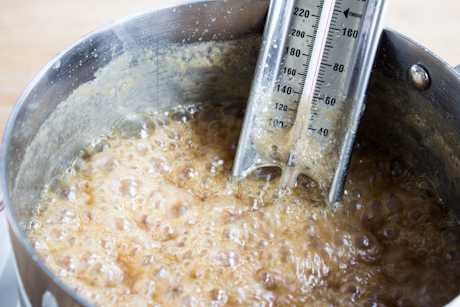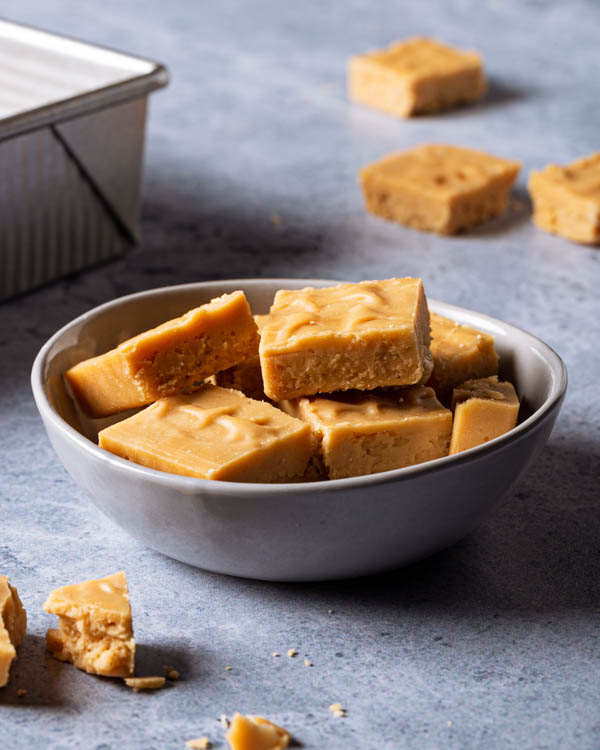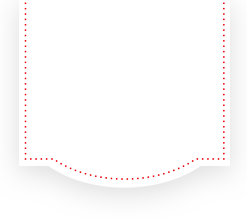Step 1
Lightly grease and line an 8-inch square pan (or a 9 x 5 inch loaf pan) with parchment paper, leaving a 2-inch overhang for easy unmolding.
Step 2
Place a heavy-bottomed saucepan over medium-low heat with the Redpath® Golden Yellow Sugar, Redpath® Granulated Sugar, milk and heavy cream. Stir constantly until mixture is completely dissolved, smooth, and with no “sandy” feel to it.
Step 3
Increase temperature to medium and stir until it just begins to boil. Do not stir at this point. Clip or insert a thermometer into the sugar mixture, making sure that the thermometer does not touch the bottom of the pan for an accurate reading. Cook the sugar mixture until it reaches between 235°F to 240°F (113°C to 116°C). This is the “soft ball stage” – a small amount of the mixture drizzled into a glass of cold water should form a ball. For firmer fudge bring the temperature closer to 240°F. Immediately remove from heat, being careful not to jostle the pan too much, and add the cubed butter, salt, and vanilla extract.

Step 4
Beat vigorously with a clean wooden spoon, large rubber spatula, or hand mixer (on low speed) until mixture begins to thicken and lose some of its shine. Once it thickens, becomes creamy in texture and appearance, and slightly loses its gloss, immediately transfer the mixture into the prepared pan, being careful not to scrape the sides of the pan where the sugar has hardened and crystallized. Smooth the top with a spatula.
Step 5
Leave the fudge to set and cool completely; several hours at room temperature or overnight.
Step 6
Using the parchment overhangs to help unmould the fudge, lift the cooled fudge from the pan and onto a cutting board. With a sharp chef’s knife, cut into 1-inch pieces or desired size. Store in an airtight container between layers of parchment for up to 2 weeks at room temperature. If kept in the fridge, fudge will last for up to 3 weeks.

*Before proceeding with the recipe, test the accuracy of your candy or food thermometer. Fill a glass completely full of ice, then fill the glass with cold water. Insert the probe of the thermometer at least an inch into the ice water, being careful not to touch the sides of the glass. If the thermometer reads 32°F (0°C), your thermometer is accurate. To test with boiling water, bring a pot of water to a rolling boil. Insert the stem of the thermometer at least an inch into the boiling water without it touching the bottom, or sides of the pan. If the thermometer reads 212°F (100°C), your thermometer is accurate. If it’s not accurate, make note of the difference and add or subtract that amount as appropriate when taking readings.
*1 cup (250 ml) of half-and-half (10% cream) can be used in place of the milk and heavy cream in the recipe.
*It is vital that the sugar is completely dissolved before the sugar begins to boil. Failure to do so will result in a granular fudge.
*If using a regular food thermometer that doesn’t clip to the side of the pan, ensure that every time you remove the thermometer from the sugar mixture that the thermometer is cleaned of all sugar crystals. If any sugar crystals are reintroduced into the mixture, it will encourage the sugar mixture to crystallize and produce a fudge that is granular in texture.
*Cooking time (and cooling time) will vary depending on whether you use a gas or electric burner, the size and thickness of the saucepan, weather, and ingredients used.
*Ensure the saucepan used has high sides; the cooking sugar will double in size when bubbling.
*Do not place the cooked sugar mixture into the fridge or freezer to quicken the cooling process; allow fudge to cool down naturally at room temperature for finer grained crystals.
*If desired, stir ¾ cup of toasted nuts (eg. pecans, walnuts, almonds, peanuts) into the mixture just before transferring the fudge into the pan.
*Have a partner when beating the fudge by hand. Your arm will thank you later! If desired, use a hand mixer, though watch carefully as it can go from creamy to set in a matter of minutes.
*Redpath® Dark Brown Sugar can be used in place of the Redpath® Golden Yellow Sugar for more pronounced caramel notes.

